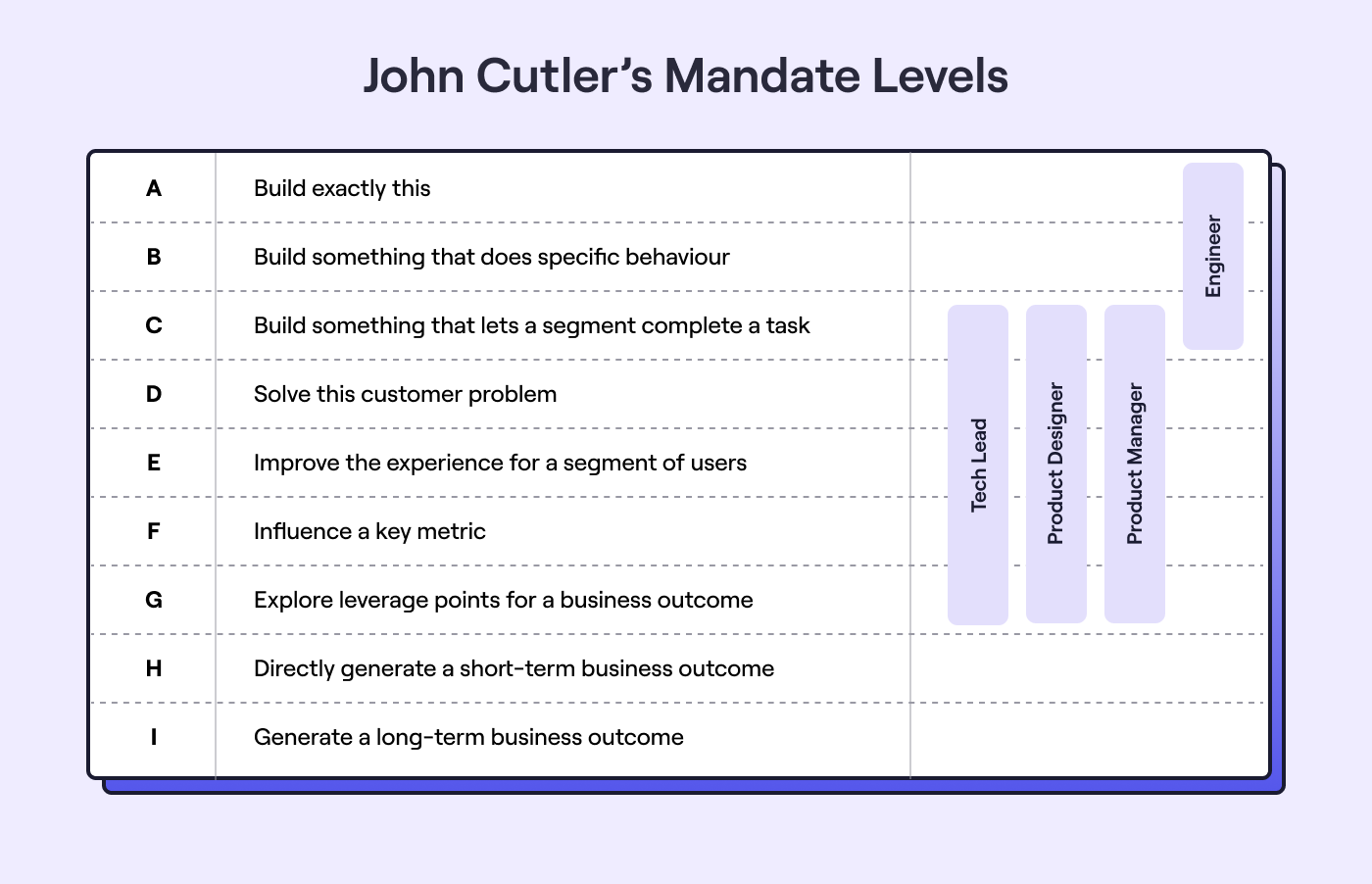The realities of moving to the product operating model
In September 2025, Hyperact hosted a panel discussion at Leeds Building Society with product and engineering leaders from eBay, Awaze, FCA, BBC, and Conflux - all actively navigating the shift to the product operating model.
The discussion centered around the messy, often uncomfortable realities of shifting established organisations towards an operating model that breaks from project-centric delivery and builds around outcomes, customer focus, and empowered, cross-functional teams.
Below are the key insights from the discussion, from leaders living this transformation right now.
The panel
- Phil Nixon (Financial Conduct Authority): Head of the Digital Delivery Hub at the Financial Conduct Authority
- Sam Higham (eBay): Head of Product at eBay
- Lucy Auckland (Awaze): Product Director at Awaze
- Stephanie May (BBC): Product Manager at the BBC
- Matthew Skelton (Conflux): Co-author of Team Topologies and CEO/CTO at Conflux
- Hosted by Sam Quayle (Hyperact): Co-founder of Hyperact
Questions
- What is the product operating model?
- Why are organisations moving to a product operating model?
- Where are organisations in their journey?
- Challenges and barriers to adopting the product operating model
- How to fund product teams vs projects
- Product leadership and governance best practices
- How to measure product operating model success
- Product operating model communication and change management
- Final advice for organisations
1. What is the product operating model?
It's a mindset shift, not a process change. The product operating model moves organisations from project-focused delivery to outcome-driven product thinking. It's not an operating model for products - it's an operating model informed by product thinking: value creation, customer focus, and strategic alignment.
- It requires organisation-wide adoption. You can't shift to the product operating model in isolation. It needs genuine executive backing and full organisational support, not just permission to experiment.
- It forces uncomfortable conversations about value. What is your product? What constitutes value? Who decides what's important? These questions often reveal how much organisational activity delivers no real value at all.
- It's a shift from authority to data. As one panellist put it: "It's no longer about the HiPPO - the highest paid person's opinion. It's actually about data and about what's really valuable. That's a huge challenge to executives.
- It impacts people at all levels. Questioning "why" and "what value" directly affects everyone's sense of purpose and sometimes their roles. Managing this resistance proactively is essential - dealing with it after it emerges is exponentially harder.
We've written a practical guide to the Product Operating Model here.
2. Why are organisations moving to a product operating model?
The old ways aren't working. Traditional project approaches consistently fail to deliver business outcomes. Everyone's seen projects drag on for years with endless governance meetings, only to deliver little tangible value.
- It's about survival, not innovation. The sheer level of change across technical, political, and economic landscapes means organisations must respond at speed. Old ways of working simply can 't keep pace.
- Competitive pressure is real. Businesses adopting product-led approaches are thriving. Every organisation wants to still be here in ten years - this is increasingly the way to achieve that.
- It builds on previous transformation models. The product operating model isn't a replacement for things like agile, DevOps, or digital transformation - it's a natural evolution. Where previous, in-vogue transformation models focus more acutely on delivery execution, the product operating model extends upstream to strategy and decision-making.
- The practitioners are now in leadership. A wave of people who've successfully implemented product thinking are now in senior positions. Other leaders are seeing the results and understanding it.
3. Where are organisations in their product transformation journey?
There's a massive spectrum. Organisations exist at wildly different levels of maturity, and most dramatically underestimate the effort required for transformation. Many aren't ready for what they think they want. One panellist compared it to someone wanting to run a marathon every week when they've never run before. You can get there, but it takes commitment and a lot of hard work.
- Build foundational capabilities first. Large organisations are investing in core competencies - experimentation capabilities, data infrastructure, and cultural change. It's not one silver bullet. You can't leap there in one go, but you can start taking steps.
- Start where you can succeed. One organisation took five years to build 20 product teams, setting up three to four annually. They started where they had the biggest challenge but also where they could succeed, learning iteratively and gradually expanding.
- No one's finished. Even organisations doing it well have continuous improvement needed. The product operating model is an ongoing journey, not a destination.
4. What are the challenges and barriers to adopting the product operating model?
Stakeholder resistance is inevitable. The biggest challenges aren't just technical, they're also human and cultural.
- Stakeholders don't understand (or care). Many stakeholders fundamentally don't understand the product operating model and have no interest in learning. You need to take them on the journey while also working at scale.
- People fear losing control. The product operating model can feel like it takes power away from stakeholders. How you manage this while empowering teams is critical.
- Executive sponsorship must be genuine. Without proper, full sponsorship - not lip service - you'll struggle to progress. This requires acknowledging that transformation can't be a side-of-desk activity.
- Perceived empowerment isn't real empowerment. Many teams look empowered but are just told "do this thing." Use frameworks like John Cutler's mandate levels to understand where teams actually operate, then build autonomy gradually. Don't assume you can jump straight to full autonomy.

- The label can create the wrong focus. "Product operating model" can get fixated on the product management function rather than whole-team collaboration. It's about how everyone works together, not just product managers.
5. How to fund product teams vs projects
Project-based funding is fundamentally incompatible with product thinking. It's like oil and water that don’t mix. This creates massive organisational dysfunction when you try to run both models simultaneously.
- Experiment with new funding approaches. Organisations are trying seed funding for discovery and research, with teams returning iteratively rather than with complete answers upfront. Portfolio funding and product lifecycles rather than projects are also being tested.
- It's a mindset shift, not just governance. The expectation of getting a timeline, number, and deliverable all at the start needs to change to "we'll develop the answer, and the outcome might not be what you expect." Building that trust takes time.
- Leadership struggles with persistent teams. The idea that teams are persistent, not temporary, requires constant reinforcement: "The website's never going to be done. So why do you think this team will finish in October?"
- Product leaders need financial literacy. Understanding P&Ls and accounting practices lets you have conversations in business terms. You can demonstrate the cost of inefficiency: "You're spending 25% of the annual headcount budget on people waiting on each other. Would you like to unlock that?"
6. Product leadership and governance best practices
Shared accountability breaks down silos. The most effective approaches bring everyone into the success story, not just product teams.
- Celebrate success across functions. If a great outcome came from collaboration with operations, bring ops on stage to talk about it. Once you start sharing success together, it's "we're operating like this together," not "product teams doing weird things."
- Create hands-on collaboration. Co-locate business colleagues, technicians, and product teams for focused problem-solving. This builds relationships and credibility.
- Proactively manage difficult stakeholders. Map out tricky stakeholders early and plan how to tackle them from first interactions. Do the hard yards - spend more time with that person, present to them first.
- Develop empathy for resistance. Some difficult people have imposter syndrome or are scared. Give them space to admit they don't know, then provide coaching. Seeing previously opposing leaders present together is hugely powerful.
7. How to measure product operating model success
Define what success looks like before you start. Most organisations don't have clear measures in place, making it impossible to know if transformation is working.
- Agree on measurement together. When you ask "what's success?" and get vague answers, push further. Break it down to something teams can actually affect, then agree that's what you're measuring.
- Define failure criteria too. Be upfront about negative signals that would trigger behaviour change. This creates accountability.
- Don't let measurement gaps stop progress. If you can't measure something yet, start work on getting that data while continuing transformation. Don't stop because you can't measure.
- Focus on business outcomes, not methodology. Care about guest satisfaction, repeat bookings, how customers feel. If those metrics aren't improving, change the approach.
- Use metrics that are hard to game. Measure things like handoffs between teams before value gets out the door. These give leaders safe levers to adjust.
If you’d like a deep-dive into aligning product metrics with business goals, we’ve written a step-by-step approach here.
It was also the topic of our panel discussion Metrics that matter: how to align product metrics with business KPIs.

8. Product operating model communication and change management
Transparency and consistency are non-negotiable. Without intentional communication, others will tell your story for you.
- Be transparent about failures and successes. Things will fail - be comfortable having that conversation openly at all levels.
- Communicate through multiple channels regularly. Use all-hands updates, planning events, and leadership blogs. If you don't talk to everybody consistently, they'll forget. Adopting lean comms can help here.
- Take control of your narrative. Be intentional and consistent. Think about different stakeholder groups - what format, frequency, and detail do they need?
- Invest in your people. Transition people with heavy coaching. Mix internal knowledge with external thinking. Give training budgets. It's about belief that people can make this change happen. Here's eight product management certifications we can vouch for, if you are looking to upskill colleagues.
- Listen for when teams are ready. Don't get stuck in persuasion mode when people are already convinced. One organisation kept building buy-in when teams were asking "when's it happening?" creating dissonance.
9. Final advice for organisations
There's no single path - it depends on your context.
- Start from the top (if you can). Top-level buy-in with everybody behind it from the executive level down is the ideal foundation.
- Start small (if you can't). When top-down isn't possible, apply product thinking to your own team. Measure what your team is trying to do, use team health surveys, and build from there.
- Build momentum through small wins. Start somewhere you can achieve success, then use that to power the next stage. If you are stuck, our blueprint for modern product development can help.
- Focus on your sphere of influence. For individual contributors, think about what culture you can change. What questions can you ask to shift thinking?
- Create "friendly FOMO". Shine a spotlight on teams doing something amazing. Get people interested. This doesn't need many people, but it does need to be continuous.
- Show, don't tell when managing up. Get leaders into scrums, demos, and retros. Share team health indicators. Use regular showcases. Once leaders see it in action, half the argument is won.
Recommended reading
- Inspired, Empowered, and Transformed by Marty Cagan, along with SVPG’s introduction to the product operating model.
- Dotwork’s Product Operating Model starter pack by John Cutler. A comprehensive reference for teams that want to go deeper. It covers team scopes, artifacts, funding models, and interaction patterns and more.
- Itamar Gilad’s operating model for product-led organisations. A systems-level view that breaks organisations into eight interconnected functions, each with clear levers for change. Practical for teams adapting an existing setup.
- The agile comms handbook by Giles Turnbull. A recommended read on how to be transparent, clear and concise as you communicate. It’ll teach you ways to document by doing, feedback loops, and how to make your approach to communication much more productive.

